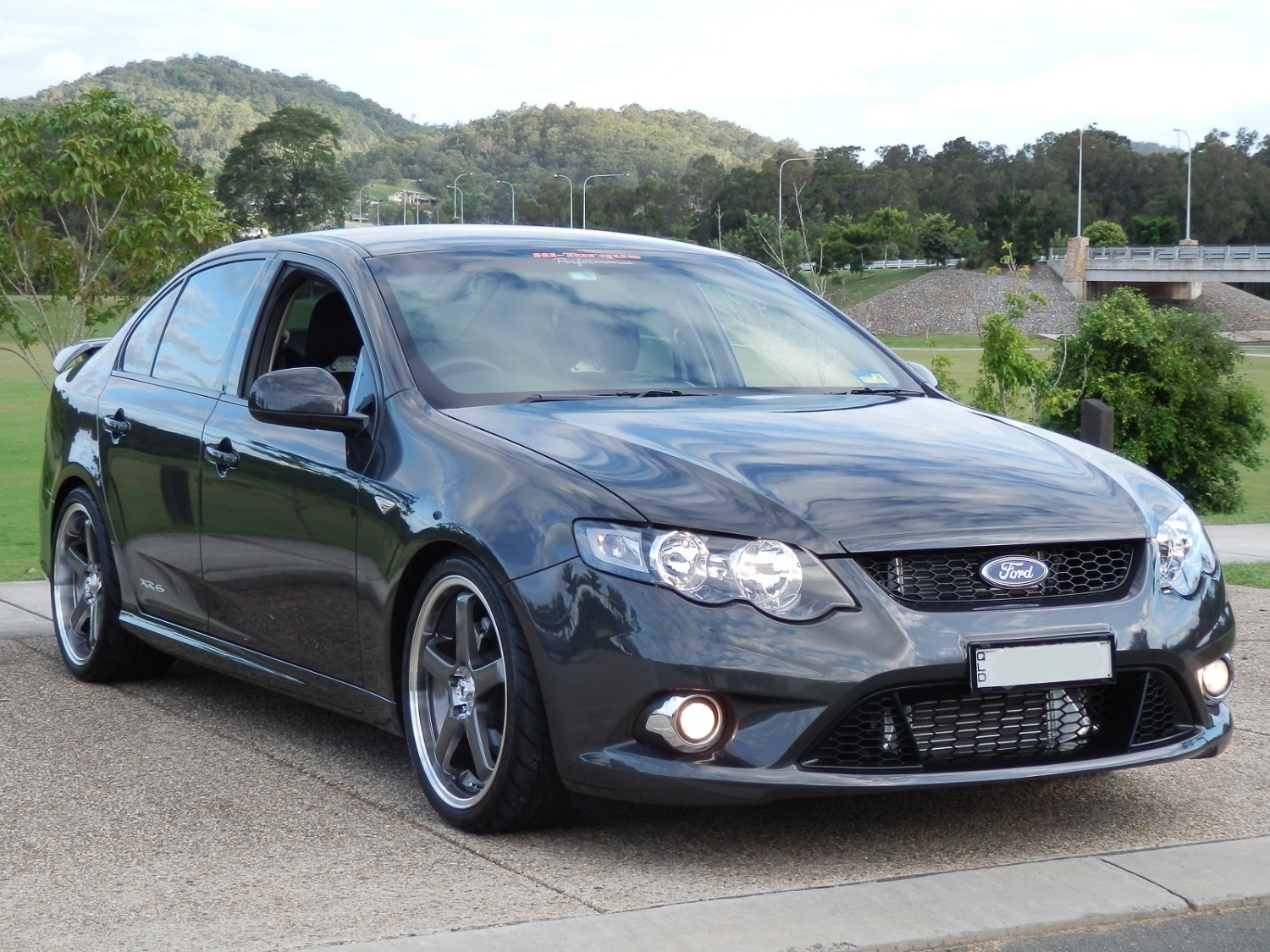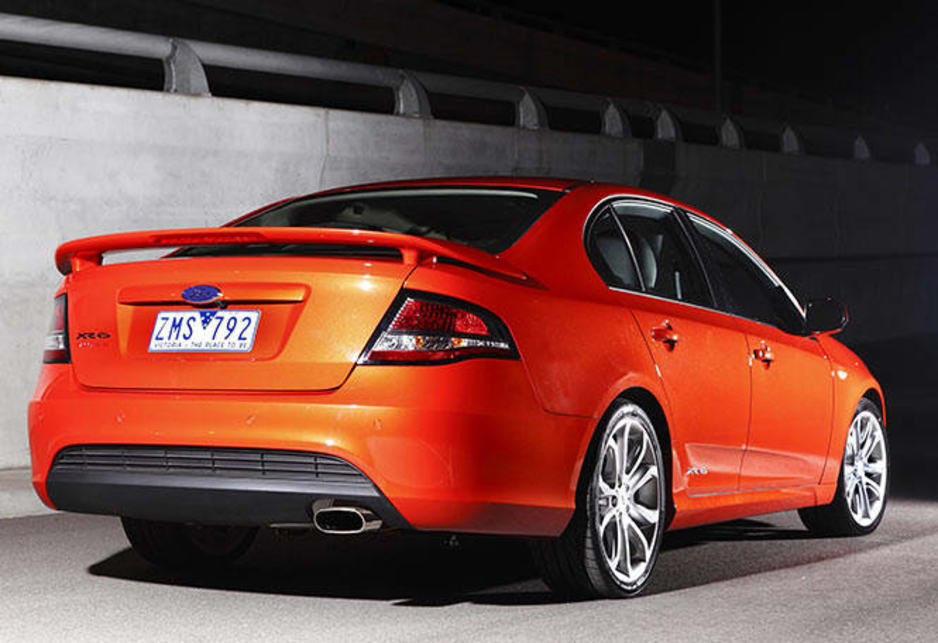It uses the same 4.0L I6 Turbo engine that is found in the G6E Turbo. The six-speed automatic transmission used in turbocharged models is the 6HP26 which is rated to handle more torque than the 6HP21 used in non-turbo models. The inline-six turbocharged engine has a maximum power of 270 kW and maximum torque of 533 N⋅m (393 lb⋅ft). The I6 engine also has the ability to provide the driver with an "over-boost" feature which engages temporarily when the throttle is fully depressed at speed & correct atmospheric measures are met.
Once correct condition's have been met, the engine will provide an increase in boost pressure of up to 12psi from a standard maximum of 10psi; which allows for power around the 300 kW mark. Falcon XR6The base model in the XR range, which features the same 4.0L I6 engine found in the XT, G6 and G6E. It can also be had with an automatic transmission, with a choice of 5 or 6-speed. Both having slightly quicker acceleration than the manual variant. As of July 2010, the 5-speed automatic is no longer available.
In 2005, I decided to purchase a dark blue 1997 EL XR6 with the five speed manual gearbox and it had the optional 16 inch Tickford alloys that really enhanced the look of the car. The XR6 had the Tickford enhanced 4.0 litre inline 6 cylinder engine that produced 164kW of power and 366Nm of torque. The engine featured an alloy cylinder head, single overhead camshaft and two valves per cylinder. Tickford cars had a more aggressive camshaft and a free flowing exhaust resulting in power and torque increases over the standard models. It certainly wasn't a high revving engine but had plenty of torque and was best through 3rd and 4th gear higher speed corners.
The big rear wheel drive sedan had a limited slip differential and put its power down quite well, particularly when a set of Bridgestone Potenza Adrenalin's were fitted. Back in 1997, it was a fast as the XR8 with a 0-100km/h time of 7.6 seconds and a quarter mile time of 15.5 seconds. This involved an improvement in fuel consumption on six-cylinder models fitted with the optional six-speed automatic. It was also announced that the LPG E-Gas models, like the petrol-powered versions of the FG sedan range, had been awarded the full five-stars in the ANCAP crash safety test.
The five-star rating, up from four, was not due to any structural changes to the FG, but by the introduction of electronic stability control which was previously only fitted to petrol-powered FG sedans. ESC was also made standard on the E-Gas BF III Falcon wagons still in production . ESC fitment was extended to the utility body styles from May 2009, excluding the base XL and R6 Ute, where it was optional. From June 2010, all sedan models received Bluetooth mobile phone integration and iPod integration as standard equipment. Up from the XT, this is the base model in the G Series. It is powered by the same 4.0L engine and was originally mated to the five-speed automatic (upgraded to the ZF six-speed automatic in 2010).
Besides the suspension, which is the sport-luxury tune found in the G6E, the drivetrain of the car is the same as the XT. It comes with front fog lights, a leather-wrapped steering wheel with mounted audio controls, rear parking sensors, sports body kit with side skirts and rear bumper, 17-inch alloy wheels. 1999 Ford Falcon Au Xr6 —Performance - The XR6 has fantastic acceleration. The sports suspension keeps the car from rolling too much yet is comfortable on bumps. Build Quality - I bought this car second hand recently. Appearance - The XR models are the only decent looking Falcons in the AU series.
I general think the AU Falcons are incredibly ugly but I don't mind the XR's so much as they have twin rounded headlights, some mild spoilers on the front and back and larger wheels. Cost - Being a 4.0 litre 6 cylinder it's not exactly light on fuel consumption. The tank holds 68 litres and the car will do about 600 km's on a tank, some city some highway driving. Not too bad but going from a 2.0 litre 4 cylinder car it costs a bit more.
The sports seats are comfortable and hold you in nicely around corners and when accelerating. The G6E is a step up from the G6, it is the replacement for the old Fairmont Ghia. It also features Mercedes-Benz styled side indicators on the side mirrors, similar to that on premium European cars.
PowertrainsThe standard FG Falcon engine is a 24-valve 4.0-Litre in-line six with VCT; which produces peak power of 195 kW at 6000 rpm and peak torque of 391 N⋅m (288 lb⋅ft) at 3250 rpm. From July 2010 production all I6 engines (excluding E-Gas models) meet Euro 4 emission standards. The ZF six-speed auto is an optional extra, the xr6 series having a 5 speed by default. The high-performance turbocharged version of the in-line-six produces 270 kW at 5250 rpm and 533 N⋅m (393 lb⋅ft) of torque from 1950 rpm; this engine is available in the XR6 Turbo and G6 E Turbo.
The Turbo variant makes as much as 480 N⋅m (350 lb⋅ft) of torque at just 1500 rpm. The standard engine for the FG range is a 24-valve 4.0-liter six-cylinder engine. The engine is capable of producing 195 kW of power at 6000 rpm.
The engine successfully meets the Euro 4 emission standards. The turbocharged engines in the Turbo models produce as much as 270 kW of power and 533 Nm peak torque. Harnessing the engine, a ZF six-speed automatic transmission is standard to almost all the trims.
Except for the XR models, which also feature a six-speed manual transmission as standard. XD Ford FalconIt's easy to forget that cars such as the XF lacked power steering though it was made standard in 1986, as were disc brakes all round. The XF was the best-selling of all Falcons, with nearly 280,000 sales. The XG discarded dated transmissions, adding a five-speed manual and four-speed auto. In 1993, the first XR6 model was released, featuring a feistier engine, quad headlights, sportier suspension, sports seats and 15-inch alloys.
The XH updated the front suspension and introduced rack-and-pinion steering. The new styling is based around the kinetic design Ford Europe uses for their cars. The interior has been improved from the previous model.
The centre console has been lifted to make for a more luxurious and spacious feeling. The interior is more roomy and has better entry and exit for front and rear passengers. The running costs are reasonable, more than a smaller car, but they definitely won't send you broke. My average fuel consumption is 9.0L/100km, but I do a lot of highway driving and generally walk to work. The previous owner got 10.5L/100km, which is also the ADR 81 average. It takes high performance tyres, which will set you back at least $300/tyre for a good set and most have a treadwear rating of around 300.
Serving is typically in the high $200 range, and they do go through bushes a bit. It's a good idea put urethane bushes in as they get replaced to save money in the long term. Someone reversed into the back of it at one point, so I can tell you that it costs about $2600 for a good quality panel beater to replace the rear bumper and beaver panel and repair the bootlid. The owner of the other car was the driver's boyfriend's dad, making her excess $3100. Speaking of insurance, if you're young, it will be expensive, but manageable if you can afford the car in the first place. Youi and Budget Direct won't insure you if you're under 30, but whatever your age, having budget insurance is like having a budget parachute.
All other models were powered by a 5.4L Boss V8 engine, which produces 315 kW at 6,500 rpm and 551 N⋅m (406 lb⋅ft) of torque at 4,750 rpm. As of October 2009, FPV released a luxury F6-E model variant, which was equipped the same as a GT E but with an F6 engine. Also in October 2009, FPV released a GS model to commemorate the historic GS nameplate from the 1970s, which was sold in lieu of a Falcon XR8. It was limited to 250 sedans and 75 utes, and was powered by a detuned V8 from the GT. Its distinguishing exterior features included unique "GS" decals and dark argent wheels.
Among its credits was becoming the first Australian-made car to achieve a five-star safety rating though, controversially, it didn't provide curtain airbags as standard. Standard features that were a step up included automatic climate control, ESP, emergency brake assist, a driver-fatigue warning and alloy wheels. The XT, XR6 and G6E models came with a 195kW 4.0-litre inline six matched to a slick ZF six-speed auto . Getting the liveliness of the 270kW turbo six were the XR6 Turbo and G6E Turbo.
While the XR is the sports model of the Falcon range, it shares its 4-litre six-cylinder petrol engine with the base XT model. Also available are a turbocharged version of this engine and an LPG-fuelled option. Topping the range is an XR8 powered by a 5.4-litre eight-cylinder engine. The engine in our XR6 review car produces a healthy 190kW and 383Nm.
Performance is quick for a large, relatively affordable family car. It is a reasonably quick car, untroubled by a full load of people - the 0-100kmh sprint is achieved in just 7.4 seconds. Ford Falcon XR6 comes standard with a six-speed manual transmission, but our test vehicle was fitted with the optional six-speed automatic transmission with sequential sport shift which increases the price by $3,000. A 4.0-litre E-Gas engine with four-speed automatic transmission with sequential sports shift can also be optioned. We have experienced the benefit of this careful development on the road and at Le Castellet circuit in the south of France. The ST, which does without four-wheel drive or a limited-slip differential, has tenacious grip, and it handles and steers with precision.
It is quick (Ford claims a believable 0-to-60 time of 6.5 seconds), copes with full power out of a tight corner without twitching the steering, has terrific brakes, and makes a suitably powerful noise. Inside the Ford Falcon XR6 – my particular favourite variant – you'll be very comfortable. The seats are cloth-trimmed, which, even though it's not as luxurious as leather, won't get damaged by seawater-soaked towels or the family dog, both of which I have to carry pretty frequently. Adjust the four-way driver power seat how you like it and feel the lumbar support cushion your back. Make sure it's set right – you'll be pushed back into it a lot if you get a chance go take the Ford Falcon out to play. All the safety features are there – pre-tensioned seatbelts, dual stage front airbags and side airbags.
Two of the optional extras I wouldn't mind getting are the child activity organiser (a real must!) and the Day Tripper 15-litre fridge. When they told me I needed two new bushes I got a second opinion and needed five plus a new timing belt. The bushes and timing belt the independent mechanic said needed changing are still perfect. The Ford dealer I went to for the last service however were not so good. They called me and told me it was ready to be picked up, and when I got there I was informed that they were still washing it with who knows what. I only use Bowden's Own and had just washed it the day before, making this service a rare instance where a car is washed and ends up less clean.
The also said that it urgently needed two new rear bushes and the tyres only had 2,000km left. They said the same two bushes were starting to wear and that they should be changed with the tyres in 5-7,000km. They were also a bit cheaper, and just generally nicer to deal with.
On the subject of servicing, and reliability, there has never been an issue with the engine or drivetrain in over 140,000km. I've got a mate with a BA and AU with 180,000 and 370,000km respectively and he's never had anything go wrong. Another mate has a VE Commodore with 150,000km that's starting to feel worn out. The only parts that have had to be changed are the usual consumables like brake pad and discs, and rear suspension bushes, which have been replaced with nolathane. The shock absorbers will be replaced for the first time next service as per the owner's' manual. Being rear wheel drive it feels balanced, and it responds well to spirited driving.
Body control is very good, it's very stable and planted, the steering feels well weighted, as do the pedals. The inline six is smooth and responsive, with a strong mid range, and sounds nicer than a V6. I will admit to having spent some time just listening to it idle.
The ride is nice, if a little firm over level crossings, and I've done several long drives in it and it's a comfortable car to be in for extended periods. Due to emissions non-compliance, the XR8 V8 was discontinued in 2010, the same year the station wagon was terminated. The upper-end models came with accoutrements such as dual-zone air, a premium audio system, leather, sat-nav and electric driver's seat.
In 2011, Ford introduced a new liquid-injection LPG system for the Falcon, marketed as EcoLPI. It boosted power by 27% and torque by 10% while fuel use dropped by 15%. XT Sport – Adds alloy wheels, six-speed automatic transmission and electronic stability control. The transmission is specifically designed for the turbo models, to handle the additional torque. The XR6 Turbo is the fastest model in the FG range, scoring 0 to 100 km/h in just 4.8 seconds. This is the base model in the XR range, powered by a 4.0-liter six-cylinder engine.
Is Ford Falcon Reliable An automatic transmission is also available as an option. It drives really well, as it is equipped with a ZF 6-speed automatic which is a really good gearbox for an automatic. The car is powered by one of the best engines Ford has ever produced; a naturally aspirated inline 6 nicknamed the Barra inline 6 which makes a healthy 190kW . A G6 Limited Edition consisting of just 1500 units, based on the G6. It's unknown how many of these 1500 units were Ecoboost.
The official fuel consumption figures are 9.9L/100km, but we averaged 12.7L/100km. The big, lusty straight-six might be easier on the wallet with Ford's LPG option, the EcoLPi. Nonetheless, the engine pulls like a freight train, and when paired up with the optional ZF six-speed automatic gearbox, the power delivery is relentless. We're sure you could get our real world economy figure down a lot lower if you were a regular highway driver. This is an excellent German-developed transmission, also used by BMW. It significantly improves both the performance of the vehicle and its fuel efficiency.
A six-speed manual is available only in the V8 and turbocharged Falcons. Formed as a joint venture between Ford and Prodrive in 2002 was Ford Performance Vehicles which produced hotter versions of Fords, especially Falcons. The BA underpinned the debut FPVs, the GT, GT-P and Pursuit Ute, the 290kW V8 range starting at about $60,000. The BA Series II facelift in 2004 introduced a six-speed manual. The 2005 BF debuted a six-speed ZF auto and ESP for selected variants. The BF II 2006 update had turbo models getting power boosts and the entry variant offering a six-speed ZF auto as an option over the four-speeder.
It was a tricky period for the Falcon XD and Holden's Commodore, with the Middle East fuel supply/price scare having car makers questioning the ongoing viability of their big, sexy and powerful yet thirsty cars. Ford dropped V8s and even considered terminating the Falcon itself. A considered replacement was smaller front-wheel drive sedan and hatch, codenamed Capricorn, but the brand opted to stay on course. Holden down-sized the Commodore, playing into Falcon's talons when the fuel crisis eased.




























No comments:
Post a Comment
Note: Only a member of this blog may post a comment.